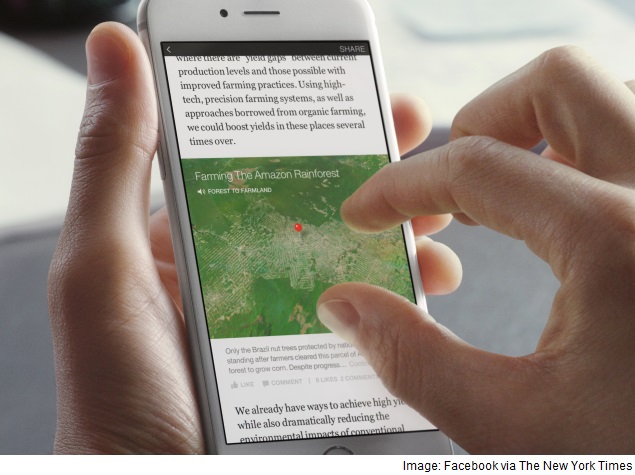- Home
- Social networking
- Social networking Features
- Why Facebook's News Experiment Matters to Readers
Why Facebook's News Experiment Matters to Readers

Tech companies have always stepped on one another's toes to try to become people's gateway to the digital world - the only place people need to go to get what they want. It's why Google, a search engine, started a social network and why Facebook, a social network, started a search engine. It's why Amazon, a shopping site, made a phone and why Apple, a phone maker, got into shopping.
Now, their reach is extending wider, to nontechnology companies like newspapers and magazines. Or, put another way, all kinds of companies are now becoming tech companies.
Facebook's experiment, called instant articles, is small to start - just a few articles from nine media companies, including The New York Times. But it signals a major shift in the relationship between publications and their readers. If you want to read the news, Facebook is saying, come to Facebook, not to NBC News or The Atlantic or The Times - and when you come, don't leave. (For now, these articles can be viewed on an iPhone running the Facebook app.)
Everyone involved recognizes that shift is already well underway. The front page of a newspaper and the cover of a magazine lost their dominance long ago. Web home pages are following suit. Increasingly, the articles, videos, photographs and graphics that media organizations publish are stand-alone fragments that readers happen upon one at a time, often on social media. It is similar to what happened to musicians when iTunes started selling individual songs instead of albums.
But news reports, like albums before them, have not been created that way. One of the services that editors bring to readers has been to use their news judgment, considering a huge range of factors, when they decide how articles fit together and where they show up. The news judgment of The New York Times is distinct from that of The New York Post, and for generations readers appreciated that distinction.
"In an analog world, you had to think of a newspaper as a collection of stories," said Edward Kim, chief executive of SimpleReach, which provides publishers and marketers with online metrics. "That's how it was packaged and distributed and sold."
"In digital, every story becomes unbundled from each other, so if you're not thinking of each story as living on its own, it's tying yourself back to an analog era," Kim said.
Traditional editors have had no choice but to give up some of their control. But who takes their place? Readers' friends who recommend articles serve as editors, and so does Facebook's algorithm.
Facebook executives have insisted that they intend to exert no editorial control because they leave the makeup of the news feed to the algorithm. But an algorithm is not autonomous. It is written by humans and tweaked all the time.
That raises some journalistic questions. The news feed algorithm works, in part, by showing people more of what they have liked in the past. Some studies have suggested that means they might not see as wide a variety of news or points of view, although others, including one by Facebook researchers, have found they still do.
When the protests in Ferguson, Missouri, broke out, they became national news. On Facebook, meanwhile, there was scant evidence that they were happening. Or what happens when editors decide the right journalistic decision is to show a photograph of a woman's breast that Facebook might not allow?
Tech companies, Facebook included, are notoriously fickle with their algorithms. Publications became so dependent on Facebook in the first place because of a change in its algorithm that sent more traffic their way. Later, another change demoted articles from sites that Facebook deemed to run click-bait headlines. Then last month, Facebook decided to prioritize some posts from friends over those from publications.
Readers are fickle, too. In 2013, 40 percent of traffic to the more than 300,000 publishers in Shareaholic network's came from search engines and 14 percent came from social media. Now, social has outpaced search.
That is why no news organization, despite being grateful for the readership from Facebook, wants to become too dependent on the network, or give up its own relationship with readers. Just as tech companies have viewed one another as both friends and competitors, news organizations now view Facebook the same way.
© 2015 New York Times News Service
Catch the latest from the Consumer Electronics Show on Gadgets 360, at our CES 2026 hub.
Related Stories
- Samsung Galaxy Unpacked 2025
- ChatGPT
- Redmi Note 14 Pro+
- iPhone 16
- Apple Vision Pro
- Oneplus 12
- OnePlus Nord CE 3 Lite 5G
- iPhone 13
- Xiaomi 14 Pro
- Oppo Find N3
- Tecno Spark Go (2023)
- Realme V30
- Best Phones Under 25000
- Samsung Galaxy S24 Series
- Cryptocurrency
- iQoo 12
- Samsung Galaxy S24 Ultra
- Giottus
- Samsung Galaxy Z Flip 5
- Apple 'Scary Fast'
- Housefull 5
- GoPro Hero 12 Black Review
- Invincible Season 2
- JioGlass
- HD Ready TV
- Laptop Under 50000
- Smartwatch Under 10000
- Latest Mobile Phones
- Compare Phones
- OPPO Reno 15 Pro Max
- Honor Win RT
- Honor Win
- Xiaomi 17 Ultra Leica Edition
- Xiaomi 17 Ultra
- Huawei Nova 15
- Huawei Nova 15 Pro
- Huawei Nova 15 Ultra
- Asus ProArt P16
- MacBook Pro 14-inch (M5, 2025)
- OPPO Pad Air 5
- Huawei MatePad 11.5 (2026)
- Xiaomi Watch 5
- Huawei Watch 10th Anniversary Edition
- Acerpure Nitro Z Series 100-inch QLED TV
- Samsung 43 Inch LED Ultra HD (4K) Smart TV (UA43UE81AFULXL)
- Asus ROG Ally
- Nintendo Switch Lite
- Haier 1.6 Ton 5 Star Inverter Split AC (HSU19G-MZAID5BN-INV)
- Haier 1.6 Ton 5 Star Inverter Split AC (HSU19G-MZAIM5BN-INV)

















